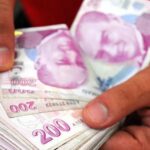New York Stock Exchange Closed Lower

The New York Stock Exchange closed lower today, with the Dow Jones index falling by 0.45% to 43,209.50 points, the SP 500 index dropping by 1.59% to 5,861.57 points, and the Nasdaq index declining by 2.78% to 18,544.42 points.
Concerns about deepening trade wars, fueled by President Donald Trump’s tariff policies, were said to keep investors on edge. Investors closely monitored Nvidia’s financial results and the macroeconomic data released. Trump had announced that tariffs on Canada and Mexico would not be lifted, and a 25% tariff on the European Union was decided upon, with details of these customs duties to be revealed soon. On the same date, March 4, tariffs on Mexico, Canada, and an additional 10% tariff on China were also set to come into effect. The US economy grew by 2.3% in the fourth quarter of 2024, in line with expectations. Core personal consumption expenditure price index also saw a revision from 2.5% to 2.7% during that period, excluding food and energy expenditures. The number of initial jobless claims in the US unexpectedly rose to 242,000, surpassing market forecasts, and durable goods orders increased by 3.1% in January, above expectations. Pending home sales in the US recorded a 4.6% decline in January, exceeding the expected drop.
Despite high inflation indicators, continued resilience in the US economy was highlighted. The 10-year US Treasury bond yield rose 2 basis points to 4.27%.
NVIDIA STARTED WITH GAINS BUT CLOSED WITH LOSSES Nvidia’s revenue rose by 78% annually to reach $39.3 billion, with net income increasing by 80% to $22.1 billion. The company’s revenue and income surpassed market expectations, with the chipmaker projecting revenue for the current quarter to be $43 billion. Analysts pointed out that Nvidia’s positive outlook, following the disruption by Chinese startup DeepSeek’s AI model, eased concerns about cooling demand in the sector. However, Nvidia’s shares began with gains before closing the day with an 8.5% loss. Kansas City Fed President Jeff Schmid stated that while survey measures of inflation expectations were flawed, with inflation reaching its highest level in 40 years, now was not the time for the Fed to lower its guard. Schmid observed that the risks to inflation seemed tilted to the upside, potentially exerting pressure on growth due to increased uncertainty, emphasizing the importance for the Fed to remain vigilant and maintain its hard-earned credibility.
FED CHAIRS’ ASSESSMENTS Cleveland Fed President Beth Hammack noted the irregular and slowing nature of the disinflation process, expressing confidence in the luxury of patience for monetary policy, likely meaning the federal funds rate would remain unchanged for a period. She mentioned that as long as the labor market remained healthy, she sought evidence for policy adjustments, pointing out that there were upside risks to the inflation outlook. Hammack did not believe that monetary policy was meaningfully restrictive and suggested they may currently be approaching a neutral environment. Philadelphia Fed President Patrick Harker also stated that the policy rate would remain sufficiently restrictive in the long term to keep inflation subdued without adversely affecting the rest of the economy.





















































































































































































































































































































































































































































































































































































































































































































































































































































































































































































































































































































































































































































































































































































































































































































































































































































































































































































































































































































































































































































































































































































































































































































































































































































































































































































































































































































































